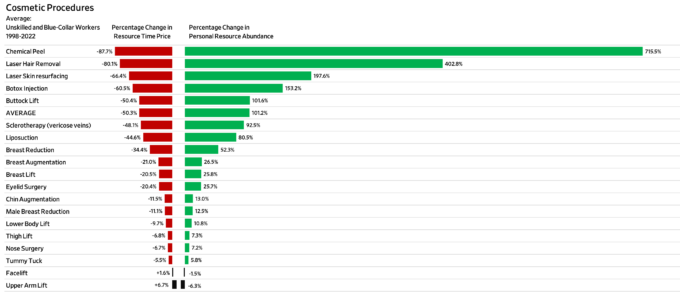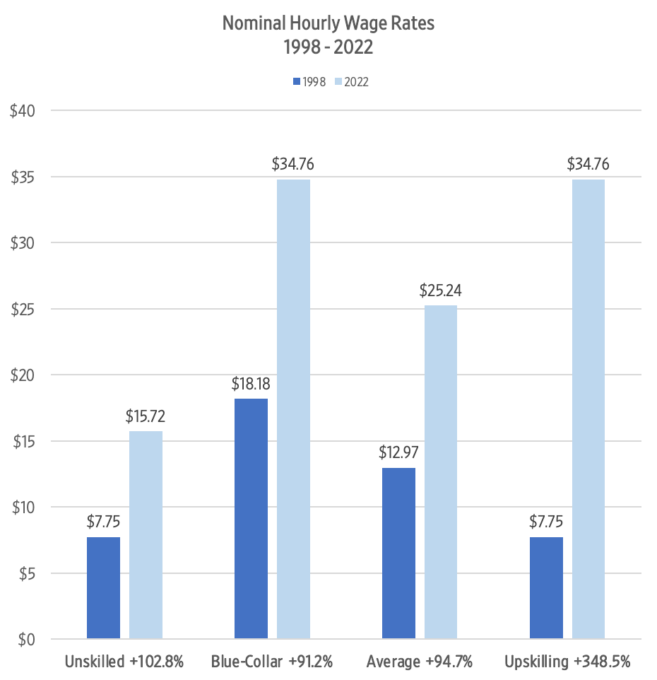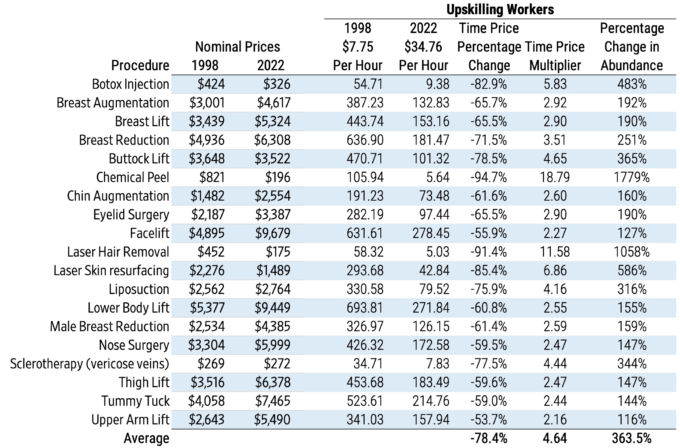Summary: Hospital services costs have surged, raising questions about the effectiveness of regulation and government intervention in the healthcare industry. To investigate the potential impact of free markets on cost trends, we examined the time prices of common cosmetic surgery procedures, which are elective and typically not covered by insurance. Our analysis reveals a significant decline in the relative time prices of these procedures, indicating increased abundance driven by innovation and market competition.
The Bureau of Labor Statistics reports that since 1998, hospital services costs have increased 61 percent faster than average wages and far outpaced consumer price index inflation. This industry is highly regulated, and government restricts supply and subsidizes demand.
Would free markets help to reverse these cost trends? To answer this question, we looked at the time prices of 19 common cosmetic surgery procedures. These procedures are elective, and insurance companies typically don’t provide reimbursements. Cosmetic surgeons also have been relatively free to innovate, and cosmetic surgery centers are globally competitive.
The American Society of Plastic Surgeons annually publishes prices for a variety of procedures. We compared the nominal prices from 1998 to 2022 against the average hourly wage rates of unskilled and blue-collar workers. This gave us relative time prices over time.
The average time price fell by 50.3 percent over this 24-year period. For the time it took to earn the money to pay for one procedure in 1998, you could get over two procedures today. Procedure abundance has increased by over 100 percent. The time price of chemical peels and laser hair removal fell the fastest by 87.7 percent and 80.1 percent, respectively. However, two procedure costs increased: upper arm lifts increased by 6.7 percent and facelifts by 1.6 percent.

The above analysis compares categories of wage earners over time, but what about individuals? We typically start as unskilled workers and then advance as we acquire more productive skills, knowledge, and experience. Categories remain constant while individuals are upwardly mobile. If we look at an unskilled worker who “upskilled” to a blue-collar worker, cosmetic surgery procedures have become dramatically more abundant.

From 1998 to 2022, nominal unskilled hourly wages increased by 102.8 percent, while blue-collar hourly compensation increased by 91.2 percent. The average between these two categories is 94.7 percent. If you started out in 1998 as an unskilled worker and moved up to a blue-collar worker, your nominal hourly compensation increased by 348.5 percent.
Comparing an upskilling worker’s hourly compensation to the prices of cosmetic procedures indicates that the average time price fell by 78.4 percent. These workers could get 4.63 procedures in 2022 for the time price of one in 1998. Personal cosmetic surgery abundance increased by 363.5 percent for upskilling workers, growing at a 6.6 percent compound annual rate, doubling every 11 years or so.

This article was published at Gale Winds on 2/21/2024.

